Cucumber variety "Vyaznikovskie" - incomparable fresh and good for winter harvesting
Cucumbers have been grown in Russia for a long time and successfully. It is difficult to imagine a summer dining table and a summer cottage without these vegetables. There are many varieties of culture with their own characteristics, taste and appearance of the fruit. Let us consider in detail the Vyaznikovsky variety of cucumbers.
The content of the article
Description of the variety
Vyaznikovsky cucumbers were known in our country back in the 19th century. They were especially actively grown in the Vladimir region. For the first time the variety was cultivated in the city of Vyazniki.
Distinctive features
The All-Russian Institute of Genetic Resources entered the variety into its register back in 1924. Born in Vyazniki, it quickly spread throughout Russia and other post-Soviet countries, especially Ukraine and Moldova.
 The reason for this is not only the good taste of the fruits and their presentation, but also the resistance of the variety to weather changes. It tolerates sudden cold snap and sudden heat well, which is especially valuable in a harsh continental climate.
The reason for this is not only the good taste of the fruits and their presentation, but also the resistance of the variety to weather changes. It tolerates sudden cold snap and sudden heat well, which is especially valuable in a harsh continental climate.
The variety belongs to early maturing (fruits ripen after 40–45 days) and bee-pollinated.
Composition and properties
Composition of Vyaznikovski cucumbers per 100 g:
- dietary fiber - 1 g;
- water - 95 g;
- vitamin A - 10 mg;
- B vitamins - 7.4 g;
- vitamin K - 16.4 mg;
- vitamin C - 10 mg;
- potassium, magnesium, phosphorus, iron, cobalt, manganese, copper, chromium, iodine - about 300 mg.
One fruit contains:
- 15-16 kcal;
- 0.9 g protein;
- 3 g of carbohydrates.
There are no fats.
The daily intake of fresh cucumbers is 300 g, pickled - 200 g.
Vegetables normalize the kidneys and intestines. In pregnant women, the regular use of cucumbers significantly strengthens the immune system, and in children from the age of one, it accelerates the formation of the musculoskeletal system.
Since Vyaznikov cucumbers are of non-hybrid origin, they rarely cause allergic reactions.
Specifications
Bushes:
- medium height;
- with green, non-wrinkled leaves of medium size;
- with short but strong whips;
- with the formation of fruits from bundle ovaries;
- with 1 stem, which usually has 4 shoots.
Fruit characteristics:
- resemble an elongated egg in shape;
- covered with noticeable small tubercles;
- length - 10-11 cm;
- color light green;
- average weight - 130-135 g.
Cucumbers of this variety are equally good in salads and in pickling. Their taste is delicate, rich due to the characteristic aromatic pulp, voids are rare.
Attention! Especially Vyaznikovsky cucumbers are valued for their lack of bitterness.
The variety is high-yielding: 2.5–3.5 kg of fruits of moderate ripeness are harvested from 1 m2.
How to grow a variety yourself
The cultivation of Vyaznikovsky cucumbers is not difficult. They are immediately sown in the ground or grown for seedlings.
Planting with seeds and seedlings
Vegetables tolerate planting with seeds in open ground. For this, a number of conditions are met:
- soil temperature - not lower than + 15 ° C;
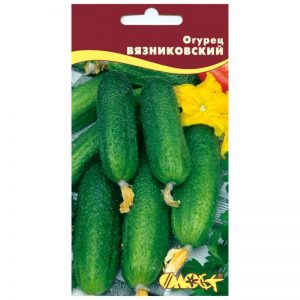
- the landing site is reliably protected from the wind;
- there should be as much sunlight as possible.
Planting is carried out after frost and during stable warm weather. In most regions of Russia, this is the end of May.
The garden bed has been prepared since autumn. To do this, dug up the ground, make a composition of 1 m2:
- deciduous humus - 5 kg;
- wood ash - 1 l;
- superphosphate - 20 g;
- potassium salt - 10 g.
The mixture is disinfected with a weak solution of potassium permanganate.
Sowing crops for seedlings is carried out around the 20th of April. The growing period should not exceed 4.5 weeks, otherwise the yield of plants will sharply decrease.
A mixture of earth, humus, peat and sand in equal proportions is best suited for cucumber seedlings. The substrate is poured with hot water for disinfection. After draining the liquid add potassium sulfate, urea, "Nitrofoska" and wood ash.
Preference is given to growing vegetables in peat cups, since the roots of the variety are fragile and do not tolerate diving well. Some people cultivate seedlings in sawdust: with this method, the root system is not damaged, but develops easily and freely. In any container, make a pallet and drainage at the bottom in the form of expanded clay or sawdust.
Before planting, seeds are placed in a saline solution (30 g of salt per 1 liter) for rejection. Use only those specimens that sink to the bottom. The planting material is disinfected in a weak solution of potassium permanganate. The soil is well moisturized.
Seeds are planted 2 per pot or hole. After germination, the weak sprout is removed.
Watering start 5 days after germination. Moisten the soil regularly, but in moderation. The pots are placed in a well-lit place, at a certain distance from each other, so that the leaves of the grown seedlings do not touch.
Important! Only warm water is used so that the seedlings do not die.
A week before planting in open ground, the plants begin to harden, periodically taking them out to the balcony or loggia.
Growing and care
There are 2 ways to grow a crop:
- whips are thrown on the ground;
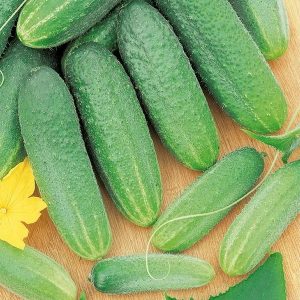
- using props.
The first option is simpler and in the case of the Vyaznikovsky variety is quite acceptable, since the whips of these cucumbers are of the same length.
However, on props, when grown vertically, the plants are more evenly illuminated, blown with fresh air and pollinated by bees. Bushes attack less pests... The yield with such cultivation is usually higher.
Warm water is poured into the holes between the rows - the soil must be constantly moist. Vyaznikovsky cucumbers are irrigated before the start of the heat in the morning or evening. This is done regularly at regular intervals. During watering, water should not fall on the leaves, so as not to burn plant tissues.
Important! Water is used not lower than + 18 ° C.
Before flowering, the culture is moistened moderately, and during the fruiting period - abundantly. The quality and quantity of the crop depends on this.
If no organic matter was introduced before sowing seeds or seedlings, the soil periodically fertilize "Ammophos" or mullein solution. Regular chicken droppings will do, but in small quantities.
The roots of the Vyaznikovsky cucumber are located close to the surface. Therefore, several times over the summer, the plants are spud up to prevent the development of fungal diseases.
For the formation of lateral shoots, on which female flowers are formed, the main stem above the 5th leaf pinch... However, if the fruits were formed early, which is typical for the southern regions, the procedure is not performed.
Features of cultivation and possible difficulties
When growing Vyaznikovsky cucumbers, farmers are faced with the formation of an insufficient number of ovaries. In this case, bees are attracted for better pollination of the bushes, planting honey-bearing flowers next to the beds or arranging drinkers with a sweet nutrient solution.
Diseases and pests
Suddenly yellowed leaves, the appearance of plaque on plants, and the cessation of fruiting speak of plant diseases. Vyaznikov cucumbers are prone to:
- powdery mildew;
- white rot;
- root rot.
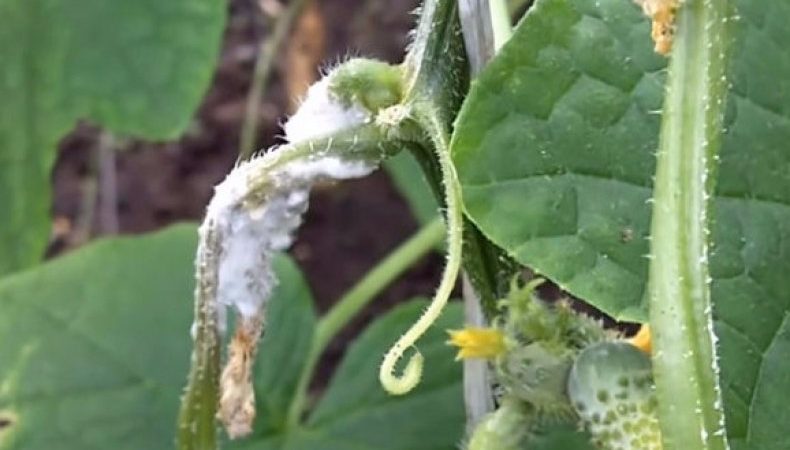
For the prevention of diseases, the bushes are treated with ash, for treatment - with fungicides, "HOM".
In conditions of high humidity, plants can attack spider mite. A solution of potassium permanganate and special biological products are used against it. Affected leaves are torn off and destroyed.
Harvesting and application of the crop
The crop is harvested regularly throughout the summer, starting in July.The first fruits are harvested 40–45 days after planting.
Cucumbers are great for both salads and pickling. During heat treatment, the pulp retains its juiciness and taste. Vegetables are also left for seeds: the variety, unlike hybrids, does not lose its qualities in subsequent years.
Advantages and disadvantages of the variety
Advantages of Vyaznikovsky cucumbers: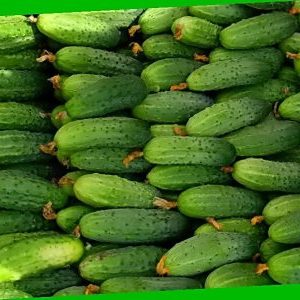
- the possibility of growing in almost all regions;
- resistance to temperature changes;
- small length and strength of the whips;
- early maturity;
- the possibility of harvesting seeds directly from the grown fruits;
- versatility in cooking.
The disadvantage is insufficient drought resistance.
Reviews
Farmers note the simplicity of growing the crop, its good fruiting, the taste of the vegetables themselves, and their versatility in cooking.
Andrey, Voznesensk: "In general, we bought a dacha recently, last year. We haven’t started experimenting yet, we plant with my wife what our parents cultivated. We stopped at the Vyaznikovsky variety. They grew it with seedlings - everything went well, the harvest was harvested all summer. But the plants were not fed and the beds were not prepared in advance, so they removed a little more than a kilogram per square meter. "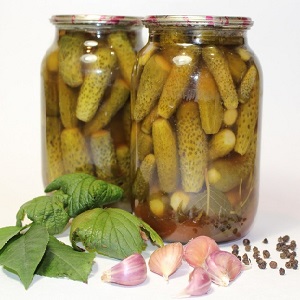
Semyon, Novgorod: “Both hybrids and traditional varieties grow on my site. Hybrids, of course, look neater and greener, as in the photo, but it seems to me that ordinary varieties are tastier, especially in salads. I have been growing Vyaznikovsky for many years, I select and store the seeds myself. Being a breeder is exciting in its own way. "
Marina, Belgorod: “I'm not a fan pickled gherkins. I believe that a cucumber in a jar should be full-bodied. The good old Vyaznikovsky variety is quite suitable for this. I also respect Nizhyn cucumbers, they are also time-tested. "
Conclusion
The Vyaznikovsky variety of cucumbers has already become popular - it is so popular with summer residents and grows everywhere. With improper care, the fruits can turn yellow and outgrow, but ripe vegetables are juicy and tender, with a characteristic crunch.
The culture is early maturing and high-yielding, resistant to temperature extremes.